How To Lose Belly Fat Fast
Ditch unwanted belly fat in less than a month with our fitness plan
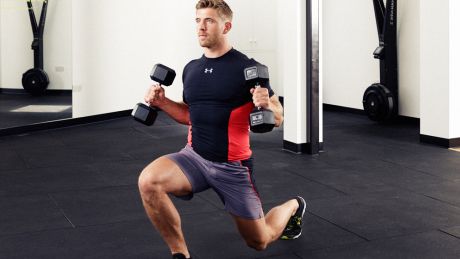
Belly fat is a stubborn, unsightly beast. It’s also dangerous. Even if you’re slim elsewhere, a pot belly raises your chances of being hit by a heart attack, stroke or diabetes.
There are a few ways to check if that weight around your midsection has put you in the danger zone, but the simplest is to wrap a tape measure around yourself just below your bellybutton. If you’re a man and the number’s 94cm (37in) or more, it’s time to take action.
While you’ll find plenty of tips on the internet to help you lose belly fat, they’re just that – tips. To make a change, and fast, you need to eat healthily but also be in a calorie deficit, so that you burn more calories than you take in.
The best approach to achieving that is to modify your diet and start exercising more. The latter is important because if you simply lose weight by eating less, you will be losing muscle mass as well as fat, and this can decrease your metabolic rate. Your metabolism is important for losing body fat and maintaining a healthy weight, and building muscle mass while losing weight is the best way to keep your metabolic rate at the same level or even increasing it.
If you’ve been put off exercising to reduce the size of your belly by the prospect of endless sit-ups, the good news is that there’s not a sit-up in sight on this plan – mainly because you can’t reduce fat from a certain area with specific exercises. Instead, this training plan consists of high-intensity exercise involving all major muscle groups, which will help shed the excess fat from all over your body. All you need is a pair of dumbbells, which are eminently affordable if you’d prefer to follow the workouts at home.
This plan isn’t for everyone though. It’s best suited to those with some experience in the gym who have fallen out of the habit. If you’ve never acquainted yourself with the proper form for fundamental exercises such as squats, lunges and presses, you may be better served by a gentler start. If you’re unfit or have a long-term health condition, this explainer on how to start exercising safely is a great place to start, as is this selection of weight loss exercises. If you’re heading back to the gym after a break, you can also try this gym machine plan for beginners, or this gentle four-week cross-trainer workout plan.
Now, on to your diet. We’ve got specific diet tips for shifting belly fat at the bottom of this article, but one general tip that can help you lose weight is to adopt a diet that’s relatively high in protein, especially when you’re exercising frequently and need to maintain your muscle mass while losing fat. Not only does protein help to repair and build your muscles, it raises your metabolic rate more than eating fat or carbohydrate does, so when you do eat protein more of the calories in it are dissipated as heat. Another advantage of protein is that it makes you feel fuller for longer than carbs or fats, so you’re less likely to feel the impulse to hit the snack cupboard between meals.
Sign up for workout ideas, training advice, reviews of the latest gear and more.
You don’t need to cut everything else out of your diet entirely, but if you’re aiming to reduce your calorie intake by around 500 calories a day, it’s best to cut back on carbs and fats while adjusting your meals so the proportion of protein in your diet is higher.
This exercise-friendly meal plan is a good option, and if you want to make things as easy as possible then check out our guides to healthy recipe boxes and meal delivery services, which can take all the hassle out of improving your diet.
But for many of us, perhaps the easiest and most effective change you can make to help you lose belly fat fast is to stop boozing. When a writer tried it for four weeks he experienced what he called “ridiculously good results from a relatively minor lifestyle change”.
How The Plan Works
Here’s what you need to know before you start.
1. You’ll Be Doing Circuit Workouts
Circuit training involves doing a certain exercise for a set amount of time or number of reps, then moving on to another exercise. Each week you’ll do four circuit workouts. Work through each exercise listed in turn to complete one round of the workout. Each session will require you to complete a certain number of rounds – in this plan each workout is five rounds. Circuit training is effective because you don’t rest much, which forces your muscles and your cardiovascular system to work harder, so you’ll be burning calories while building muscle.
Each round of the circuit finishes with a “supermove”, which involves doing as many reps as possible in 60 seconds – while maintaining good form, of course. This ensures you finish each round having given it your all.
2. You’re Against The Clock
In these circuit workouts you’ll complete the first four exercises working to a set amount of time, rather than reps. Try to pace yourself and complete a similar number of reps for each exercise every round. Note how many reps you completed, then aim to beat those scores when you next do the session. Working to time also helps you keep the pace high throughout the workout, and also means the sessions will suit people of all abilities, since a beginner will simply do fewer reps in the time than an experienced gym-goer but still aim to beat their score next time. You also get to pick one of three difficulty levels of the supermove to match your fitness ability.
3. It Has Weekly Progression Built In
Progression is key to the success of any good training plan, since you need to push yourself harder as you get fitter in order to get the results you want. While you’ll be doing the same four circuits each week, you’ll increase the amount of time you work in weeks three and four. Each set will last 50 seconds instead of 40, which – as you’ll discover – is a far bigger jump in difficulty than it sounds. Remember to track your rep count each week so you can progress by trying to beat that number next time around.
Week 1: Do exercises 1-4 for 40sec, then do the supermove for 60sec. Record your reps to give yourself a target for next time.
Week 2: Do exercises 1-4 for 40sec, then do the supermove for 60sec. See if you beat your previous week’s score.
Week 3: Do exercises 1-4 for 50sec, then do the supermove for 60sec. Because the time increases to 50sec per exercise, you won’t be looking to beat last week’s score.
Week 4: Do exercises 1-4 for 50sec, then do the supermove for 60sec. You should be posting your best scores yet.
See related
- 13 Expert Weight-Loss Tips
- This High-Fibre Meal Plan Is About As Healthy As It Gets
- Fat-Loss Workouts: Five Circuits To Build Muscle
- The Benefits Of A High-Protein Diet
The Best Dumbbells To Use
This training plan shows how much you can achieve with just a set of dumbbells, and it’s certainly going to be more convenient (and cheaper) to pick up a set for your home rather than heading to a gym to complete the workouts. We have an extensive round-up of the best dumbbells you can buy for your home, but there are few pairs we think are worth highlighting for this particular workout plan.
That’s because the renegade row exercise pops up in two sessions where you have to support yourself in the press-up position while holding dumbbells. Anyone who has ever done a renegade row will know that a dumbbell with a flat side makes the move far easier because it provides a more stable base than a round dumbbell. The York rubber hex dumbbells fit the bill, and give you a wide range of weights to pick from. If you’ve spent some time in the gym you’ll know what kind of weight suits you, although we’d err on the side of lighter because you’re doing 30-odd minutes of exercise with minimal rest – the final round is going to feel a lot tougher than the first. If you can afford them, selectorized dumbbells like this PowerBlock set are even better because they offer eight levels of weight from 1.8-14.5kg.
How To Warm Up Before Your Workout
In each of the circuits below you’ll be working against the clock to complete as many reps as possible exercise, and there’s no rest between sets until you get to the end of the round. It’s a demanding style of training and given the variety of exercises you’ll be doing, you need to warm up muscles all over the body to give it your best and reduce any risk of injury.
You can follow the routine in this explainer on how to warm up at the gym but, in brief, you’ll start with a series of general dynamic stretches to loosen up your muscles, then move on to warm-ups that are specific to the exercise you are about to do. This can be as simple as doing the exercises without any weight or very light weights, or stretches focusing on the muscles you are going to challenge most in your session.
It should take you no more than ten minutes to get a good warm-up that will allow you to start your workout firing on all cylinders, which is exactly what you need to do if you’re looking to shift belly fat fast.
Circuit 1
Do each move for 40sec in weeks one and two and 50sec in weeks three and four, then rest for 2min between rounds. Do 5 rounds.
1 Squat curl
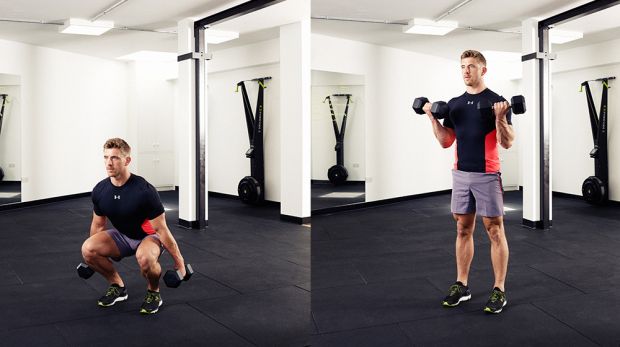
How With feet shoulder-width apart, simultaneously bend at the hips and knees to lower towards the floor with your chest up and your weight on your heels. As you straighten up, curl the dumbbells up to your shoulders.
Why The squat part of the exercise works your entire lower body. Holding the dumbbells for the duration of the set works your grip strength, and the biceps curl adds an extra muscle and cardio challenge to raise your heart rate.
2 Bent-over row
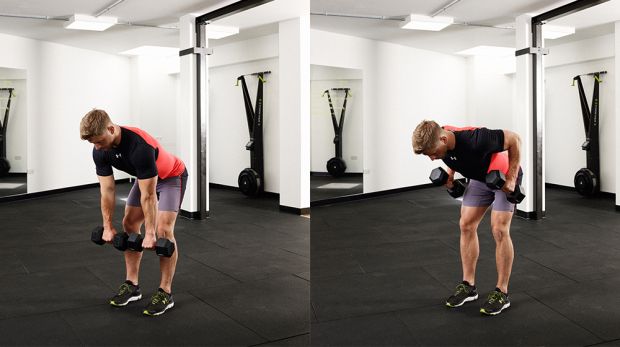
How Stand tall with your chest up and core braced, holding a dumbbell in each hand. Bend forwards – hingeing at the hips, not the waist – then row the weights up to your sides, leading with your elbows. Lower back to the start.
Why Using dumbbells for this back exercise will ensure that you get equal muscle development on both sides and gives you a big range of motion so you can concentrate on squeezing your shoulder blades together at the top of the move.
3 Romanian deadlift
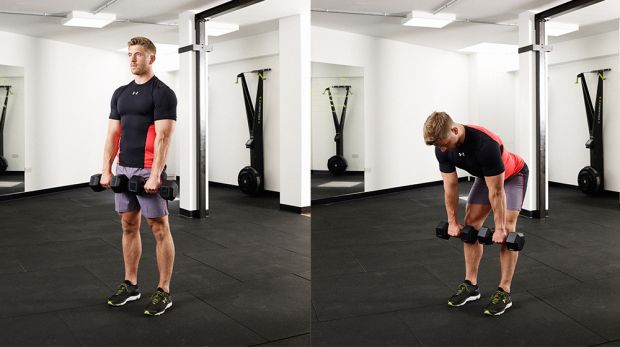
How Keeping your legs straight, lean forward – hingeing at the hips – and lower the weights down the fronts of your shins until you feel a good stretch in your hamstrings. Then return to the start.
Why This deadlift variation shifts the emphasis to your hamstrings. Doing it with dumbbells will ensure each arm gets to hold its share of the weight.
4 Overhead press
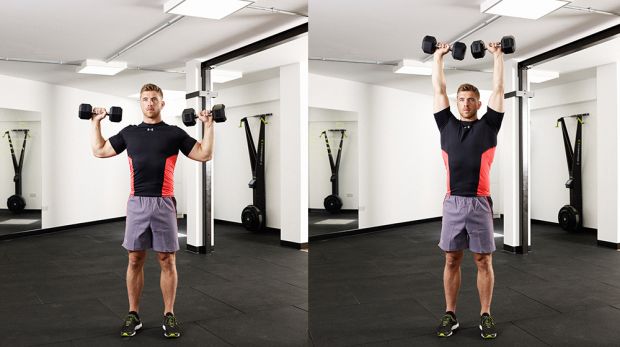
How Stand tall with your chest up and core braced, holding a dumbbell in each hand at shoulder height with palms facing forwards. Press the weights directly overhead until your arms are straight, then return slowly to the start.
Why Following a legs exercise with a shoulder move in a circuit allows you to keep your intensity, and therefore your heart rate, high because you’re working completely separate body parts. This will maximise the calorie burn.
Supermove
Select the move for your level and do as many reps as you can in 60sec.
Beginner: Press-up
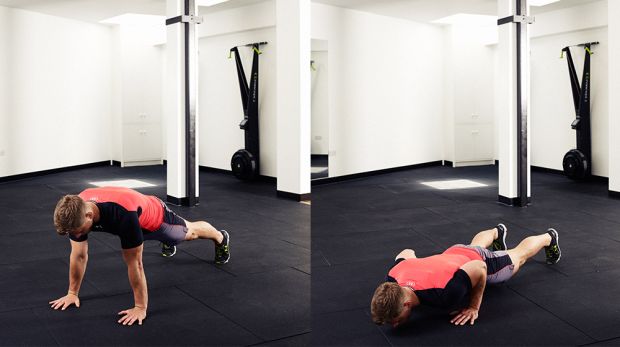
Start in the press-up position with hands directly underneath your shoulders, your core and glutes braced, and feet together. Bend your elbows to lower your chest to the floor, then press back up powerfully to return to the start.
Intermediate: Wide press-up

Start in the normal press-up position but with your hands out wide. Bend your elbows and lower your chest down towards the floor. Once you are as low as you can comfortably go, press powerfully back up to the start.
Advanced: Diamond press-up

Start in a press-up position but with your thumbs and forefingers together to form a diamond shape. Lower your chest to the floor, keeping your elbows close to your sides, then press back up.
Circuit 2
Do each move for 40sec in weeks one and two and 50sec in weeks three and four, then rest for 2min between rounds. Do 5 rounds.
1 Lunge curl
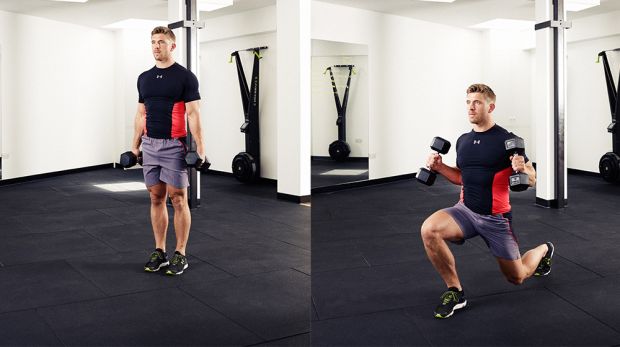
How Holding dumbbells, take a big step forwards and lower until both knees are bent 90°, keeping your front knee over but not in front of your ankle. At the same time, curl the weights up to your shoulders. Alternate sides.
Why The lunge works every major muscle in your lower body while also providing a test of balance and co-ordination. The biceps curl element makes it an extra-challenging start to the circuit.
2 Renegade row

How Start in a press-up position, holding a dumbbell in each hand. Keeping your core braced, row one hand up, leading with your elbow, then lower it back to the floor. Alternate sides with each rep.
Why Think of this move as a brutal version of the plank – it works your back muscles while challenging your stabilisers to keep you level. Make sure you control the movement to get the maximum benefit.
3 Press-up

How Start in the press-up position with hands directly underneath your shoulders, your core and glutes braced, and feet together. Bend your elbows to lower your chest to the floor, then press back up powerfully to return to the start.
Why Press-ups offer a safe and effective way of working your chest muscles hard, but only if you do them correctly. Concentrate on the quality of the movement, rather than bashing out lots of “junk” reps.
4 Wide overhead press

How Stand tall with the dumbbells by your shoulders. Engage your core and your glutes to give yourself a stable base and simultaneously press both weights overhead and slightly out to the sides.
Why Changing the angle of the press provides a different challenge to your shoulder muscles from a conventional overhead press. Just make sure the weights go more up than out, to avoid over-stressing your shoulders.
Supermove
Select the move for your level and do as many reps as you can in 60sec.
Beginner: Split squat
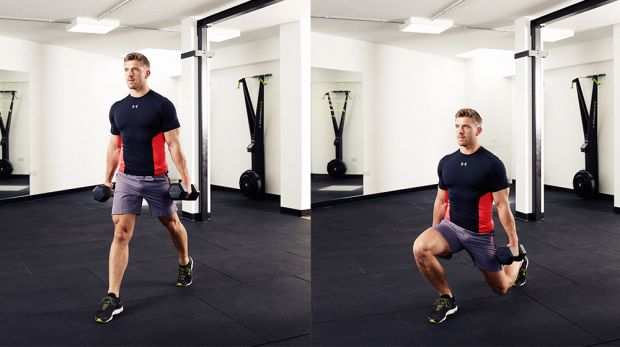
Start in a split stance, with one foot in front of the other, holding a dumbbell in each hand. Bend both legs until your trailing knee touches the floor. Straighten both legs to return to the start, then go straight into the next rep.
Intermediate: Squat
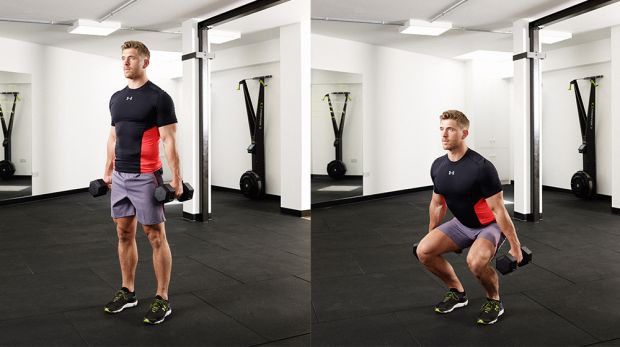
Stand with your chest up and core braced, holding a dumbbell in each hand. Bend your knees to squat down until your thighs are at least parallel to the floor, then press down through your heels to return to the start.
Advanced: Jump squat
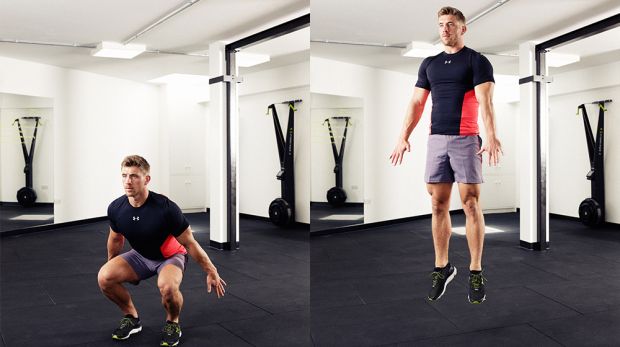
Squat down as described above, then explode upwards, aiming to get as much height as possible. Absorb the impact of the jump as you land, sinking into the next squat and repeating the exercise.
Circuit 3
Do each move for 40sec in weeks one and two and 50sec in weeks three and four, then rest for 2min between rounds. Do 5 rounds.
1 Squat press
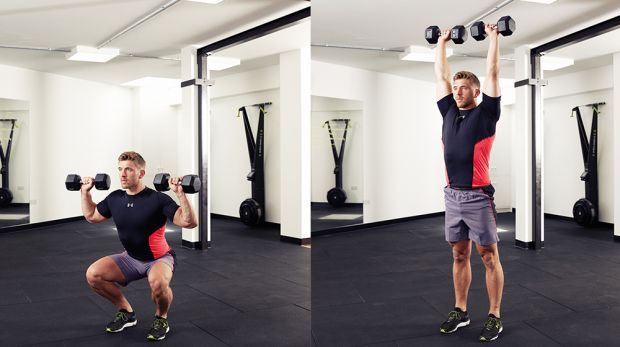
How Start with the weights at shoulder height and your feet shoulder width apart. Squat down until your thighs are parallel to the floor, then straighten up while pressing the weights directly overhead.
Why This exercise provides a real cardio challenge because it takes a lot of effort to go from a deep squat to standing up with the weights overhead. Pace yourself and make sure your form is good.
2 Reverse-grip bent-over row

How Stand tall with chest up and core braced, holding a dumbbell in each hand with palms facing forwards. Bend forwards from your hips, then row the weights up to your sides, leading with your elbows. Lower back to the start.
Why Switching to a reverse grip provides a challenge to your biceps as you draw the weights in to your sides. This is useful because that muscle group isn’t targeted elsewhere in the workout.
3 One-leg Romanian deadlift
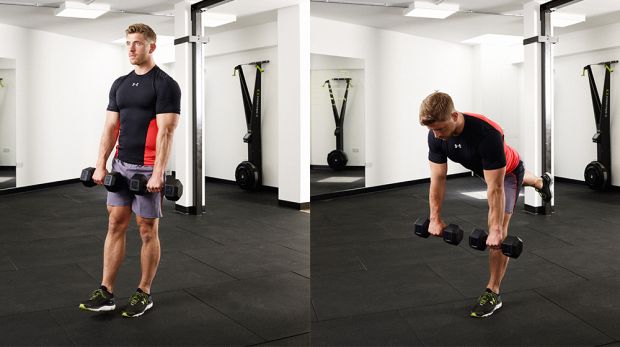
How Stand on one leg, holding dumbbells. Bend forward at the hips until you feel a strong stretch in the hamstrings in your standing leg, then straighten back up to complete the rep. Do half the given time on one leg, then switch.
Why This move challenges your balance and proprioception – your body’s sense of where its different parts are positioned – while firing up your hamstrings. To get an extra benefit, squeeze your glutes at the top of the move.
4 Lateral raise
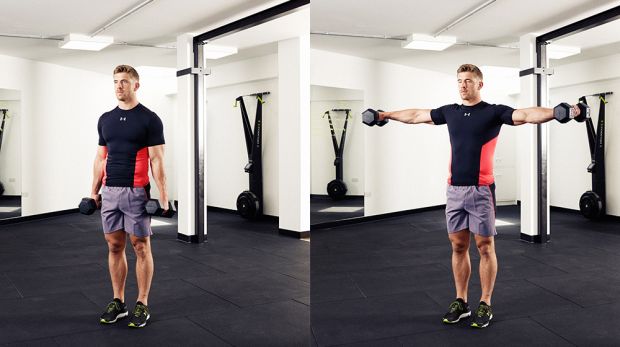
How Stand tall with your chest up and core braced, holding a dumbbell in each hand. Raise the weights out to the sides, leading with your elbows, until they reach shoulder height. Lower them slowly to return to the start.
Why If done correctly, this is a highly effective way of adding size and width to your shoulders, putting you on the fast track to a great-looking upper body. Make sure you follow the form guide closely to maximise the benefit.
Supermove
Select the move for your level and do as many reps as you can in 60sec.
Beginner: Side to side press-up

Get in a press-up position with your hands slightly wider than normal. Lower to the bottom of the move, then shift your body to just above one hand, then over to the other. On the next rep, go to the other side first.
Intermediate: Spider-Man press-up
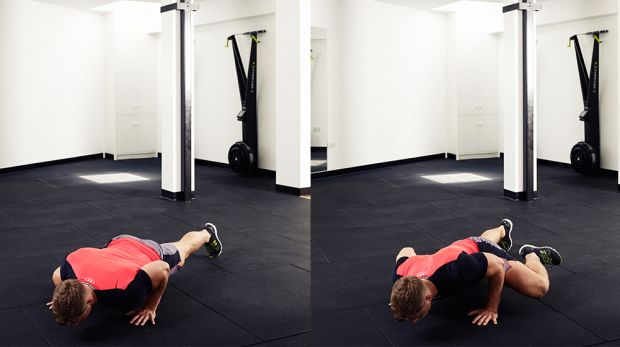
Get into a press-up position. As you lower to the bottom of the move, lift one foot off the floor and raise the knee to your elbow. Press back up, placing your foot back on the floor. Repeat on the other side.
Advanced: Divebomber press-up
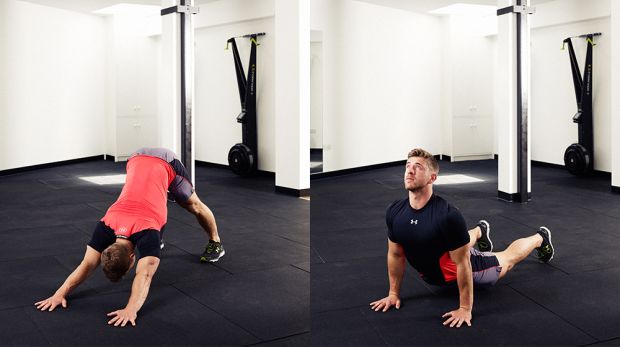
Start in a press-up position, then raise your hips and bend your elbows. Lower your head and chest down and forwards, moving your torso in a smooth arc so you end up with you head and chest raised. Reverse the movement to return to the start position.
Circuit 4
Do each move for 40sec in weeks one and two and 50sec in weeks three and four, then rest for 2min between rounds. Do 5 rounds.
1 Lunge press
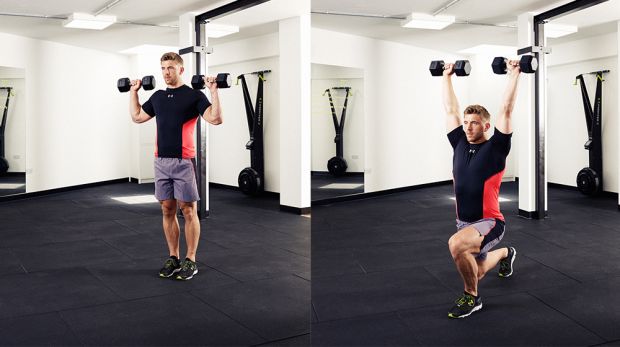
How Holding dumbbells at shoulder height, lunge forwards so that your front knee is over your front ankle. As you lunge, press the weights directly overhead, making sure they go up and not forwards. Alternate sides.
Why This move is a great co-ordination challenge and also a test of your shoulder mobility. If yours is poor, you’ll find you hunch as you press and push the weights forwards.
2 Renegade row
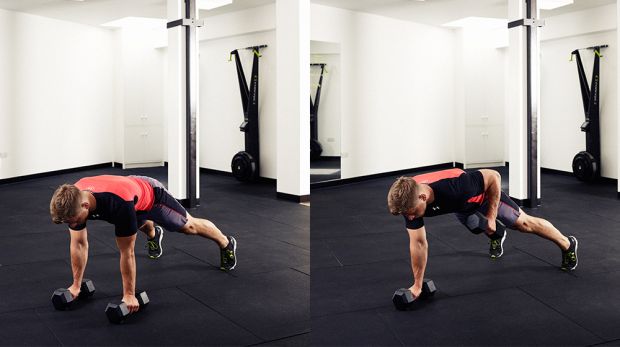
How Start in a press-up position, holding a dumbbell in each hand. Keeping your core braced, row your right hand up, leading with your elbow, then lower it back to the floor. Alternate sides with each rep.
Why As before, it works your back muscles while challenging your stabilisers. For an extra challenge, it’s even tougher on rounded dumbbells.
3 Press-up

How Start in the press-up position with hands directly underneath your shoulders, your core and glutes braced, and feet together. Bend your elbows to lower your chest to the floor, then press back up powerfully to return to the start.
Why Press-ups offer a safe and effective way of working your chest muscles hard, but only if you do them correctly. Concentrate on the quality of the movement, rather than bashing out lots of “junk” reps.
4 Reverse flye

How Leaning forwards at the hips with a weight in each hand, keep your back flat and bring the weights upwards as if you were spreading your wings, aiming to bring your shoulder blades together at the top of the move.
Why This move targets your rear delts, while building stability through your shoulder region and rotator cuffs. It’s more important to focus on the quality of muscle contraction than to churn out more reps by swinging the weights around.
Supermove
Select the move for your level and do as many reps as you can in 60sec.
Beginner: Lunge
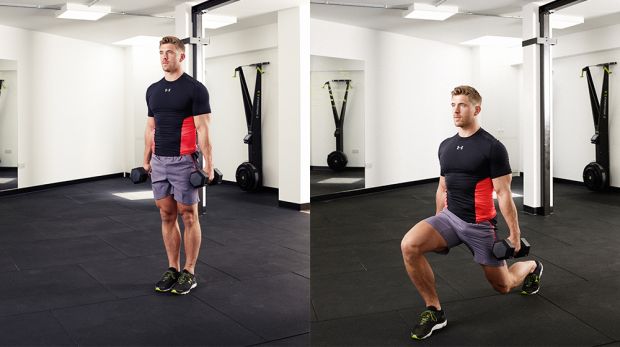
Stand with your chest up and core braced, holding a dumbbell in each hand. Take a step forward and lower until both knees are bent 90°. Push back off your front foot to return to the start. Repeat, leading with your other leg. Alternate sides.
Intermediate: Reverse lunge
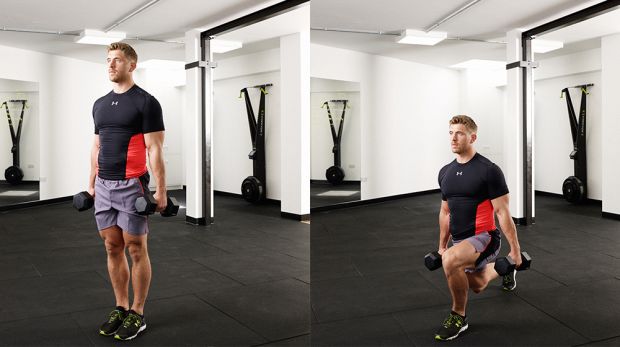
Stand with your chest up and core braced, holding a dumbbell in each hand. Take a step backwards and lower until both knees are bent 90°. Push back off your back foot to return to the start. Repeat, leading with your other leg. Alternate sides.
Advanced: Lunge jump

Starting from a lunge position, drive up into a jump, switching legs in the air and landing in a lunge on the other side. Try to absorb the impact of the jump as you land and go seamlessly from one rep to another.
Diet Tips To Help You Lose Belly Fat
Here’s the reality: it doesn’t matter how hard you train in the gym if you don’t put the same time, effort and focus into what you do in the kitchen. The old saying that “you can’t out-train a bad diet” is something of a cliché, but like all clichés it’s rooted in truth. And if you want to make big changes to how you look with your shirt off – and as quickly as possible – then you need to start thinking more about mealtimes. Here’s our expert advice on how you can start to eat smarter and torch body fat faster.
1. Fuel for the day ahead
When following this training plan breakfast is the most important meal of your day because what you eat first thing helps dictate better eating habits until bedtime. A breakfast made from lean protein, healthy fats and fibre – think eggs, bacon, and yes, some green vegetables – provides a sustained release of energy, so hunger won’t hit before lunch.
2. Swap sarnies for salad
Swapping a pre-packed sandwich and crisps for a big bowl of green leaves, mixed veg and chicken, tuna or another quality protein will help shrink your belly fast. A lunch like this will provide muscle-building protein, more stomach-filling fibre to ward off cravings, and an abundance of vitamins and minerals to keep your fat-torching mission on track.
3. Refuel during dinner
Your final meal of the day needs to be high in protein, especially if you’ve just worked out to help the repair of your damaged muscles. Baked salmon, grilled steak or chicken breasts on top of a pile of grilled or roasted veg will provide all your body needs. Add avocado or home-made hummus for some healthy fats to allow your body to better absorb certain vitamins.
4. Be clever with carbs
To lose belly fat quickly you need to be smart with your carbs. A small amount of certain carbs, like sweet potato or wholegrain rice, with dinner after training can aid recovery and help you get to sleep quicker. But the sugars and processed carbs found in chocolate, cakes, biscuits and sodas should be avoided if you want to burn fat and not gain it.
5. Drink like a fish
Being hydrated is crucial to getting lean quickly because if your body is struggling with the mental and physical problems of dehydration, it doesn’t have the resources or inclination to burn fat. Aim to drink at least three litres of water a day – carry a big bottle with you and sip frequently – and drink more on training days to ensure you stay hydrated.
6. Pick the right snacks
To burn fat you need to be in a calorie deficit (expending more than you take in) so inevitably you will feel hungry at times. Nutrient-dense snacks – nuts, natural yogurt, beef jerky – will fill you up and top up your intake of protein, healthy fats, vitamins and minerals. Avoid high-sugar nutrient-light snacks. If you’re craving a sweet snack, just rely on the readily available, perfectly ripe selection of fruit available nowadays: apples, oranges, grapes, cherries, we could go on for days. You’ll knock off one of your five-a-day, the fibre will help keep you full and that juicy sweetness can’t be beaten.

Sam Rider is an experienced freelance journalist, specialising in health, fitness and wellness. For over a decade he's reported on Olympic Games, CrossFit Games and World Cups, and quizzed luminaries of elite sport, nutrition and strength and conditioning. Sam is also a REPS level 3 qualified personal trainer, online coach and founder of Your Daily Fix. Sam is also Coach’s designated reviewer of massage guns and fitness mirrors.
